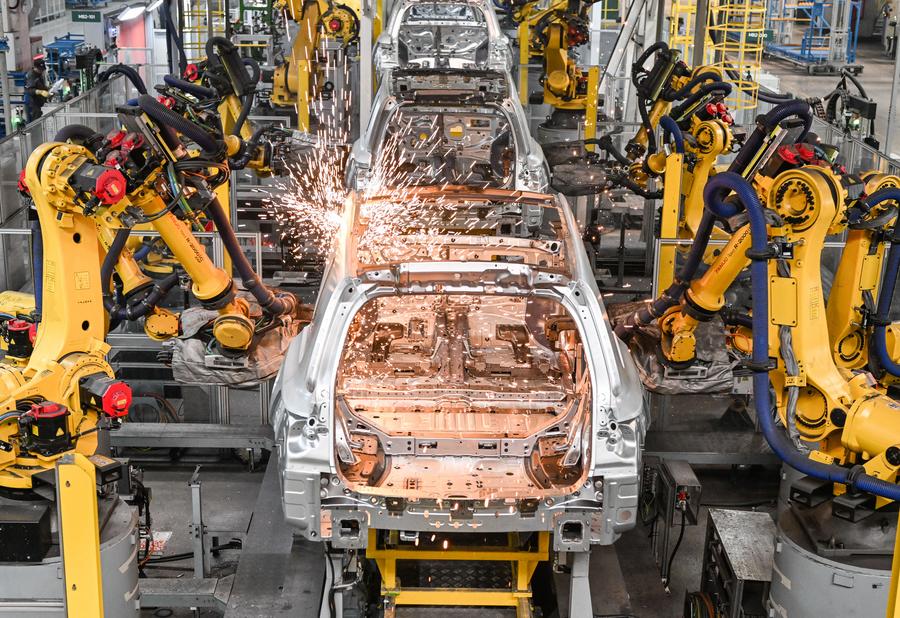The Interplay of Development and Governance in China’s Modernization Strategy

Unleashing and developing productive forces, and providing governance capabilities that match the modern state, remain the two threads of reform.
Since 1978, China’s policy of reform and opening up has been pivotal in propelling the nation toward big achievements. Its distinct and unique path of development has thrived due to a system and mechanisms that have been continually fine-tuned and strengthened through ongoing reforms.
Today, the country enters a new stage of modernization, one with Chinese characteristics.
Over the past 46 years, the evolution of China’s institutional reforms can be categorized into two primary focuses: development-oriented and governance-oriented. These dual focuses have coexisted since 1978, with the balance of emphasis shifting post-2013.
The initial phase of development-oriented reforms commenced with the Third Plenary Session of the 11th Communist Party of China (CPC) Central Committee in 1978. The shift toward striking a balance between development-oriented reforms and governance-oriented reforms took off with the Third Plenary Session of the 18th CPC Central Committee in 2013.
Effectively managing the relationship between development and governance is essential for China’s strategy of national rejuvenation, which aims for both development and stability amid global changes of unprecedented scale.
Moreover, this management plays a pivotal role in realizing the vision of Chinese modernization.
Two threads
At the onset of its reform and opening up, China’s productive forces were underdeveloped. Consequently, the focus initially was on development-oriented reforms, with the primary objective being to unleash and enhance said forces. This involved stimulating the vitality of market entities, accelerating economic growth, and improving both the living standards of the people and the national economic strength.
Key measures of this early reform period included rural reforms that began in the late 1970s, followed by the overhaul of state-owned enterprises and pricing system adjustments in the early 1980s. These reforms aimed to smoothen the transition from a predominantly state-controlled, or planned, economy to one that included more market mechanisms.
The Third Plenary Session of the 14th CPC Central Committee in 1993 marked a shift by proposing the establishment of a socialist market economy, wherein the market would be tasked with playing a fundamental role in resource allocation under national macro-control. This approach was further emphasized during the Third Plenary Session of the 16th CPC Central Committee in 2003, which proposed expanding the market’s basic role in resource distribution.
The reform initiatives during this period mainly focused on establishing and refining the socialist market economy. The objective was to stimulate motivation among people, enterprises and local governments, to unleash and develop productive forces, and to foster sustained and robust economic growth.

Concurrently, governance-related reforms were implemented to address prominent issues that emerged at different times. For example, the Fifth Plenary Session of the 13th CPC Central Committee in 1989 aimed to rectify the economic order and manage disruptions in the production, construction, and distribution sectors.
While continuously advancing development-oriented reforms, an emphasis on modernizing the national governance system and its capabilities arose. This shift aimed to provide solid institutional frameworks for building a modern socialist country.
In 2013, the Third Plenum of the 18th CPC Central Committee adopted a decision on major issues concerning comprehensive reform, elevating governance-oriented reforms to the overarching goal of the country’s reform.
This document broadened the scope of governance-oriented reforms. It set forth the overarching goal of comprehensive reform to improve and develop socialism with Chinese characteristics, and to advance the modernization of China’s national governance system and capacities.
Targeting multiple sectors, including the economy, politics, culture, society, ecology, national defense, military and Party governance, the decision emphasized that the reform of the economic system was to be the focus of this comprehensive reform.
The key task was to find the optimal balance between the roles of the government and the market, ensuring that the market plays a decisive role in resource allocation while the government better performs its regulatory functions.
The shift toward equal emphasis on both development-oriented and governance-oriented reforms was informed by both real demands and theoretical guidance.
After more than 30 years of development-oriented reforms, addressing issues that had emerged became a societal imperative and an inevitable aspect of the Party’s governance strategy. For example, poverty eradication, a rule-of-law government, achieving common prosperity and environmental sustainability all required urgent attention.
Jumping these hurdles was not only necessary to realize the goal of a moderately prosperous society, xiaokang in Chinese—its achievement being a major target ahead of the CPC centennial in 2021, but also to advance China’s modernization journey.
Over the past decade, and to this day, maintaining stable economic growth and employment has remained a critical objective. The necessity for development-oriented reforms to unleash and enhance productive capacities continues to be relevant.
Now, high-quality development requires both development-oriented and government-oriented reforms. These dual reforms are necessary to sustain growth and improve regulatory effectiveness, guaranteeing balanced progress across economy and government alike.

Reform in the new stage
Development and stability are the two core tasks on the modernization agenda. Whether the relationship between the two can be managed correctly is key to the smooth advancement of modernization. The goal of reform in the new stage is to provide institutional guarantees for the Chinese path to modernization.
Unleashing and developing productive forces, and providing governance capabilities that match the modern state, remain the two threads of reform.
Strengthening development-oriented reforms is still vital as the country outlines its two-phase path to modernization. The first phase targets achieving a per-capita GDP by 2035 that aligns with moderately developed countries.
Currently, the global environment is marked by increasing complexity and uncertainty, exacerbated by the economic aftermath of the three-year COVID-19 pandemic and ongoing long-cycle structural adjustments. These factors have weakened China’s growth momentum, putting pressure on sustaining long-term development.
To address these challenges, the annual Central Economic Work Conference in December 2023, outlining the economic agenda for the 12 months ahead, underscored the necessity of boosting China’s internal growth drivers. The country must promote deeper-level reform and high-level opening up to enhance productivity and economic vitality.
The Central Government has also proposed the concept of “new quality productive forces.” The term represents enhanced productivity that moves beyond traditional economic growth models and paths of productivity development. These forces emphasize hi-tech solutions, efficiency and quality, aligning with the principles of China’s high-quality development philosophy.
While accelerating reforms in a range of economic fields, China must also progress reforms in education, science and technology, and the development and aggregation of talent, to generate new growth drivers for high-quality development.
The governance-oriented reforms, too, must not stop. The Chinese path toward modernization is a multi-faceted development goal, which seeks to resolve the contradiction between unbalanced and inadequate development and the people’s ever-growing need for better quality of life. While promoting economic growth, institutional improvement in social harmony, common prosperity and environmental protection cannot and must not be stopped. This ensures the coordination of development and stability.
For example, the acceleration of new, people-centered urbanization requires both development-oriented reforms, such as granting permanent urban residency to eligible citizens moving from rural to urban areas, and governance-oriented reforms, such as modernizing urban management techniques.

Additionally, as living standards rise, a need has emerged for development-oriented reforms that continuously improve the quality of products and services, alongside governance-oriented reforms that strengthen quality and safety regulations.
The tasks at hand
After more than 40 years of progress, we must continue to push forward the reforms and continue to innovate.
Development-oriented reforms should prioritize lifting total factor productivity.
Initiatives here include ensuring market-oriented pricing, leveling the playing field for all types of enterprises, promoting a mixed-ownership reform in state-owned enterprises and establishing a state-owned asset supervision system that mainly manages capital, accelerating the movement of populations and their associated resources between urban and rural areas, and enhancing the role of the market in cross-border resource allocation.
Governance-oriented reforms, on their part, should zoom in on addressing societal conflicts and enhancing social harmony.
This involves clearly defining the roles and financial responsibilities of central and local governments, to delegate more decision-making power to local governments.
Tax reform should be promoted to ensure social benefits are matched with taxes paid and to maintain local governments’ fiscal sustainability.
Revenues from the transfer of rural resources should primarily be used to bolster the social security of the rural population.
Meanwhile, the interests of the private sector should be effectively protected. Discriminatory practices toward the private sector should not be allowed and the legislative process of a private sector promotion law should be accelerated.
Efforts should also be made to nurture green development through improved institutional mechanisms, such as related laws, plans, standards, information disclosure, financial policies and carbon trading markets, to integrate ecological and environmental protection with economic development.
Additionally, strengthening community-based social governance is essential. This should include shifting the focus of governance and services toward community levels, enhancing the governance systems of both urban and rural communities, reinforcing the foundation of basic-level social governance, and meeting the public’s growing desire for transparency and involvement in social management.
The author is president of the China Society of Industrial Economics and a professor of economics at the University of Chinese Academy of Social Sciences.
 Facebook
Facebook
 Twitter
Twitter
 Linkedin
Linkedin
 Google +
Google +










